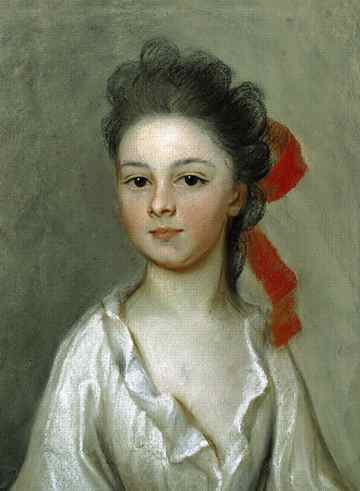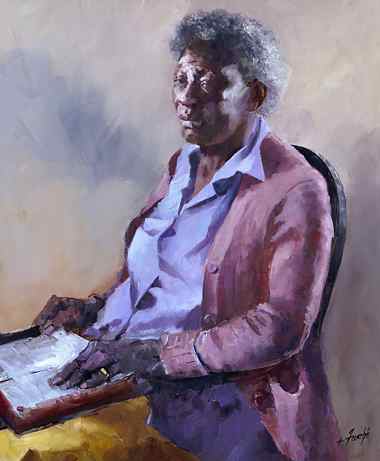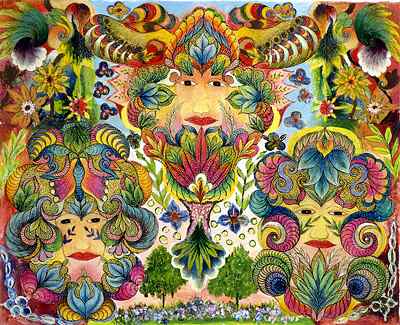Editor's note: The Gibbes Museum of Art provided
source material to Resource Library for the following article. If
you have questions or comments regarding the source material, please contact
the Gibbes Museum of Art directly through either this phone number or web
address:
Breaking Down Barriers:
300 Years of Women in Art
October 28, 2011 - January 8, 2012
 Drawn
from the museum's permanent collection, Breaking Down Barriers: 300 Years
of Women in Art highlights a number of extraordinary women working in
a variety of media and artistic styles. The exhibition pays tribute
to those women who defied convention and paved the way for women to achieve
success as professional artists. (left: Henrietta de Beaulieu Dering
Johnston (ca. 1674 -1729), Henriette Charlotte Chastaigner (Mrs. Nathaniel
Broughton), 1711, Pastel on paper, 14 2/5 x 11 3/5 inches. Gift
of Victor A. Morawetz. Image courtesy Gibbes Museum of Art)
Drawn
from the museum's permanent collection, Breaking Down Barriers: 300 Years
of Women in Art highlights a number of extraordinary women working in
a variety of media and artistic styles. The exhibition pays tribute
to those women who defied convention and paved the way for women to achieve
success as professional artists. (left: Henrietta de Beaulieu Dering
Johnston (ca. 1674 -1729), Henriette Charlotte Chastaigner (Mrs. Nathaniel
Broughton), 1711, Pastel on paper, 14 2/5 x 11 3/5 inches. Gift
of Victor A. Morawetz. Image courtesy Gibbes Museum of Art)
In the 1700s, women faced considerable obstacles to becoming
professional artists, primarily caused by social pressures and the lack
of access to formal artistic training. Henrietta Johnston moved to Charleston
(then known as Charles Town) in 1708 when the Church of England's Society
for the Propagation of the Gospel in Foreign Parts appointed her husband,
Gideon Johnston, Commissary for South Carolina. The Johnston family faced
considerable financial hardships upon arriving in Charleston, and to help
support her family, Henrietta created and sold pastel portraits. Henrietta
Johnston is considered to be the first female professional artist in America
and the Gibbes Museum of Art houses the largest public collection of her
work. Five pastel portraits by Henrietta Johnston are included in the exhibition.
Women artists from the Charleston Renaissance period are
also well represented in the exhibition. During this period of time between
the two World Wars, Charleston experienced a resurgence in all aspects of
cultural life including literature, music, historic preservation, and the
visual arts. Among the leaders of the Charleston Renaissance were artists
Alice Ravenel Huger Smith, Elizabeth O'Neill Verner, and Anna Heyward Taylor,
all of whom created numerous works depicting the historic architecture and
beautiful landscape of Charleston and the surrounding Lowcounty region.
The exhibition also recognizes the impressive cadre of
female artists working in the region today from sweetgrass basket maker
Mary Jackson to classically trained, realist painter, Jill Hooper, Breaking
Down Barriers: 300 Years of Women in Art honors the achievements of
past generations while acknowledging the creativity of professional female
artists working in the 21st century.
Breaking Down Barriers: 300 Years of Women in Art is
sponsored by BlueCross BlueShield of South Carolina,
The Women's Council of the Carolina Art Association, and Where magazine.
Wall panel text from the exhibition
- Art history has long been dominated by male artists.
A number of factors prevented women from achieving prominence as artists;
primary among them was the lack of access to formal training. In the past,
women were denied entrance to schools and academies and were not permitted
to work from nude models -- crucial training for an artist aspiring to
create highly-prestigious history paintings. In essence, societal constraints
prevented women from having the opportunity to become professional artists.
-
- Opportunities for women began to expand in the late nineteenth
century, as academic institutions began accepting female artists. Social
pressures, however, continued to discourage women from pursuing a career
in the arts. While women were encouraged to draw and paint as part of a
well-rounded education, they were expected to become wives and mothers,
not professional artists -- an expectation that continued well into the
twentieth century.
-
- Within this context, Breaking Down Barriers: 300 Years
of Women in Art explores the lives and works of female artists included
in the Gibbes collection. From Henrietta Johnston, the first female professional
artist in America, to the women artists working in Charleston today, this
exhibition celebrates the achievements of those who defied convention and
paved the way for women to achieve success as professional artists.

(above: Virginia Fouché Bolton (American, 1929 -
2004), Blessed Are They That Mourn for They Shall Be Comforted, ca.
1988, Oil on canvas, 43 x 37 inches. Gift of the artist in memory of her
husband, Donald Gail Bolton "who knew that I was an artist before I
did and encouraged me to do my best." Image courtesy Gibbes Museum
of Art)

(above: Minnie Evans (American, 1892-1987), Designs,
Wrightsville Beach, 1968, Collage with oil, crayon, and pencil on canvas,
22 _ x 26 3/8 inches. Museum purchase with funds provided by the National
Endowment for the Arts Living Artist Fund. Image courtesy Gibbes Museum
of Art)
Related Programming
- Women in Art Lecture Series
- Lectures are at 6pm, followed by a reception
- Wednesday, Nov. 2 - Renowned Charleston watercolorist
Mary Whyte
- Wednesday, Nov. 9 - Erica Hirshler, Curator of American
Paintings at the Museum of Fine Arts, Boston
- Wednesday, Nov. 16 - Interior Designer to the stars Mario
Buatta
- Fee.
-
- Curator-Led Tour
- Conducted by Pam Wall, Gibbes Curator of Exhibitions
- Thursday, November 3 and Thursday, December 1 at 2:30pm
- Free with museum admission
-
- Charleston Chamber Opera Presents
- The Diva's Come Undone
- Opera vignettes in celebration of the exhibition
- Sunday, November 6, 3pm
- $15 Members, $25 Non-Members
Resource Library readers may also enjoy:
- A multimedia
presentation by the Gibbes Museum of Art website concerning Henrietta
Johnston's Henriette Charlotte Chastaigner
- Exhibition-related article
by Pamela S. Wall, curator of exhibitions at the Gibbes Museum of Art,,
from Autumn/Winter 2011 issue of Antiques & Fine Art Magazine
- A video interview on the Gibbes Museum of Art website with curator Pam Wall and executive
director Angela Mack by Adam Parker, courtesy of the Post & Courier
- Women Artists from TFAO's Topics in American Art
Read more articles and essays concerning this institutional
source by visiting the sub-index page for the Gibbes Museum
of Art in Resource Library
For further biographical information please see America's Distinguished Artists, a national
registry of historic artists.
Search Resource
Library for thousands of articles and essays on American art.
Copyright 2011 Traditional Fine Arts Organization, Inc., an Arizona nonprofit corporation. All rights
reserved.
 Drawn
from the museum's permanent collection, Breaking Down Barriers: 300 Years
of Women in Art highlights a number of extraordinary women working in
a variety of media and artistic styles. The exhibition pays tribute
to those women who defied convention and paved the way for women to achieve
success as professional artists. (left: Henrietta de Beaulieu Dering
Johnston (ca. 1674 -1729), Henriette Charlotte Chastaigner (Mrs. Nathaniel
Broughton), 1711, Pastel on paper, 14 2/5 x 11 3/5 inches. Gift
of Victor A. Morawetz. Image courtesy Gibbes Museum of Art)
Drawn
from the museum's permanent collection, Breaking Down Barriers: 300 Years
of Women in Art highlights a number of extraordinary women working in
a variety of media and artistic styles. The exhibition pays tribute
to those women who defied convention and paved the way for women to achieve
success as professional artists. (left: Henrietta de Beaulieu Dering
Johnston (ca. 1674 -1729), Henriette Charlotte Chastaigner (Mrs. Nathaniel
Broughton), 1711, Pastel on paper, 14 2/5 x 11 3/5 inches. Gift
of Victor A. Morawetz. Image courtesy Gibbes Museum of Art)
